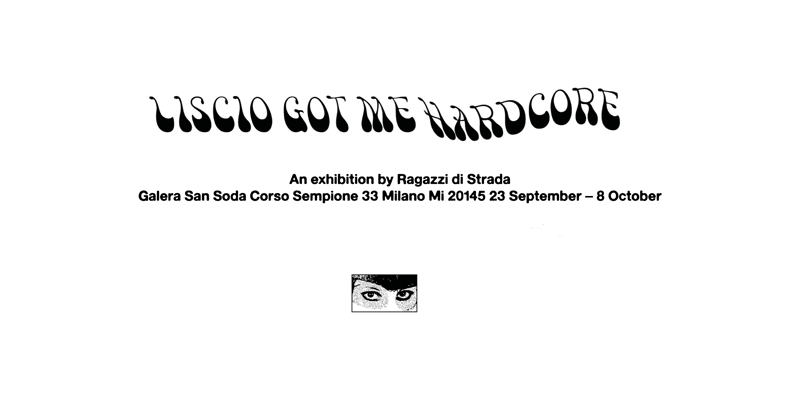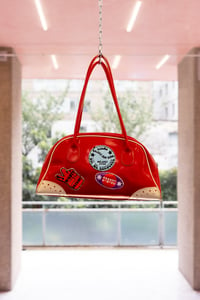SEVEN DAYS TOO LONG (HANDBAG) RAISSA PARDINI x RAGAZZI DI STRADA
The installation reimagines the iconographic heritage and social practices of the Northern Soul scene by establishing a parallel with Liscio and its culture.
The London-based, Italian graphic designer and artists Raissa Pardini (Maneskin, Gucci, Arlo Parks, Squid, Orielles, IDLES and many more), whose work is part of the permanent collection of the Victoria and Albert Museum, teamed up with Ragazzi di Strada to design an exclusive set of six patches that nod to those issued by Northern Soul venues and club nights, as well as those typical of the Glam and Bootboy culture of 1970s England, adopting Liscio claims and themes.
The outcome is an installation, which turns into a fashion accessory, that celebrates the mutual use made by the two scenes of leather bowling bags to carry dancing shoes, a towel and talc to scatter on the dancefloor to make moves smoother.
The bag is made to order, using deadstock bowling bags and six hand-stiched patches.
NB: The bag colour may change according to availability. Get in touch via email to further discuss this.
NB1: Message us for shipping outside of Italy.
---
LISCIO GOT ME HARDCORE
Liscio Got Me Hardcore is the long-awaited debut exhibition by Italian youth culture archive Ragazzi di Strada, which will take place from 23 September 2023 to 8 October 2023 at Galera San Soda in Milan, Italy.
The exhibition is the outcome of a three-year research on Liscio, a forgotten and overlooked music scene belonging to the folkloristic tradition of Italian region Emilia-Romagna, of its aesthetic and cross-subcultural meanings. It follows-up a long sold out fanzine bearing the same title issued in 2020, and it is set out to be the first and most comprehensive exhibition in its kind exploring Liscio from such a point of view.
Through rare and previously unpublished archive materials (photographs, magazines, posters, ephemera, vinyl) from the 1960s to the 1980s, audio-visual footage and artist installations ranging from textile to graphic design, the exhibition aims to offer a new interpretation of Liscio as a 'lost' subculture of Italian history and to celebrate the importance of community and collective ecstasy on the dancefloor as a form of resistance and research for an indigenous identity in a world that at the time (the 1970s and 1980s) was beginning to become increasingly globalised.
To achieve so, the exhibition looks at Liscio from the so far unexplored point of view of design, fashion and architecture, using both the material collected and the installations to trace reflections on the farsighted hybridisation between this traditional music genre and other youth scenes of the time which took place in Liscio’s ballrooms – the so called ‘balere’.
Liscio is also put in dialogue with other scenes that in the very same years, from Emilia-Romagna to the rest of the world, shared similar aesthetics, but that were also responsible for igniting a communitarian relationship with the dancefloor. These include genres such as Northern Soul, the soundsystem culture of the Jamaican diaspora, but also Afrobeat, American Gospel as well as Hardcore-Punk, which was coming up at the same time.
Acclaimed graphic designer, artist and DJ Raissa Pardini (her works are part of the permanent collection of the Victoria & Albert Museum in London, as well as having collaborated with many renowned brands, music artists and festivals including Maneskin, Gucci, Glastonbury Festival, Awesome Tapes from Africa, Orielles, IDLES, and many more) and graphic designer and lecturer Michele Galluzzo (Fantasia Type), who recently contributed to the Italian Pavilion at the Venice Architecture Biennale, will join Ragazzi di Strada with their own artworks exploring both print and textile to offer their own contemporary interpretations of the meanings and legacy of Liscio.
The exhibition will be accompanied by a 400-page catalogue featuring all the material collected, many of which are previously unseen and that won’t be on display.
Since the whole project, as always in the case of Ragazzi di Strada is fully independent and self-supported, we are pledging for your help to cover some of the costs of the exhibition.
For this reason we have set up a series of bundles, ranging from 5 to 70 Euros, which you can purchase to contribute to the exhibition. On top of the rewards, all donors will see their name in the catalogue.
After more than five years of independent research and providing weekly nuggets from the vaults of Italian subculture history, you can now support Ragazzi di Strada back, by contributing to the successful outcome of what stands as our most ambitious project so far.

